
Hugh Lupus Grosvenor, 1st Duke of Westminster,, styled Viscount Belgrave between 1831 and 1845, Earl Grosvenor between 1845 and 1869, and known as The Marquess of Westminster between 1869 and 1874, was an English landowner, politician and racehorse owner. He inherited the estate of Eaton Hall in Cheshire and land in Mayfair and Belgravia, London, and spent much of his fortune in developing these properties. Although he was an MP from the age of 22, and then a member of the House of Lords, his main interests were not in politics, but rather in his estates, in horse racing, and in country pursuits. He developed the stud at Eaton Hall and achieved success in racing his horses, winning the Derby on four occasions.

Richard Grosvenor, 2nd Marquess of Westminster, styled The Honourable Richard Grosvenor from 1795 to 1802, Viscount Belgrave from 1802 to 1831 and Earl Grosvenor from 1831 to 1845, was an English politician, landowner, property developer and benefactor.

Eaton Hall is the country house of the Duke of Westminster. It is 1 mile (2 km) south of the village of Eccleston, in Cheshire, England. The house is surrounded by its own formal gardens, parkland, farmland and woodland. The estate covers about 10,872 acres (4,400 ha).
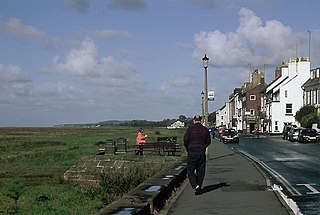
Parkgate is a village on the Wirral Peninsula in Cheshire, England, on the banks of the River Dee, adjoining 100 square kilometres (39 sq mi) of salt marsh. At the 2011 Census, it had a population of 3,591.

Edward Blore was a 19th-century English landscape and architectural artist, architect and antiquary.
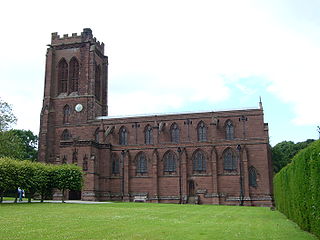
Eccleston is a village and former civil parish, now in the parish of Eaton and Eccleston, in the borough of Cheshire West and Chester, in the ceremonial county of Cheshire, England. The village is approximately 2.7 miles (4.3 km) to the south of the city of Chester, near to the River Dee. The village is situated on the estate of the Duke of Westminster who maintains his ancestral home at nearby Eaton Hall.

St Mary's Church is in the village of Eccleston, Cheshire, England, on the estate of the Duke of Westminster south of Chester. The church is recorded in the National Heritage List for England as a designated Grade I listed building. It is an active Anglican parish church in the diocese of Chester, the archdeaconry of Chester and the deanery of Chester. Its benefice is combined with that of St Mary, Pulford. The Dukes of Westminster are buried in the adjacent Old Churchyard.

Eaton Chapel is a private chapel to the north of Eaton Hall in Eaton Park, near the village of Eccleston, Cheshire, England. It is recorded in the National Heritage List for England as a designated Grade I listed building.

St Mary's Church is located on Overleigh Road in Handbridge, an area south of the River Dee, in the city of Chester, Cheshire, England. It is also known as the Church of St Mary-without-the-Walls, which was to distinguish it from Church of St Mary-on-the-Hill across the River Dee within the city walls. The church is recorded in the National Heritage List for England as a designated Grade II* listed building. It is an active Anglican parish church in the diocese of Chester, the archdeaconry of Chester and the deanery of Chester.
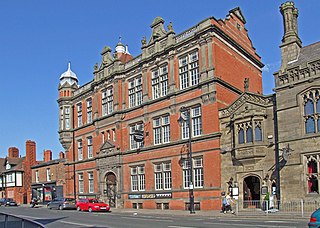
Grosvenor Museum is a museum in Chester, Cheshire, in the United Kingdom. It is recorded in the National Heritage List for England as a designated Grade II listed building. Its full title is The Grosvenor Museum of Natural History and Archaeology, with Schools of Science and Art, for Chester, Cheshire and North Wales. It takes its name from the family name of the Dukes of Westminster, who are major landowners in Cheshire. The museum opened in 1886, it was extended in 1894, and major refurbishments took place between 1989 and 1999. Its contents include archaeological items from the Roman period, paintings, musical instruments, and a room arranged as a Victorian parlour.
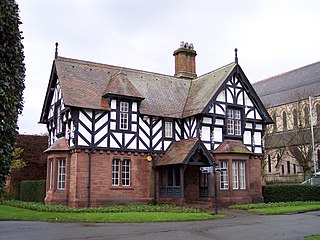
Grosvenor Park is a public park in the city of Chester, Cheshire, England. It consists of 20 acres (8.1 ha) of land overlooking the River Dee. It is regarded as one of the finest and most complete examples of Victorian parks in the North West of England, if not nationally. On 22 August 2013 the designation of the park was raised from Grade II in the National Register of Historic Parks and Gardens to Grade II*.
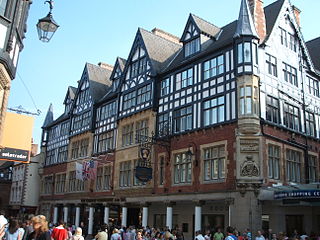
The Chester Grosvenor Hotel is a hotel in Chester, Cheshire, England. The Grade II listed building was built between 1863 and 1865 and is owned by the Duke of Westminster.

6–11 Grosvenor Park Road is a terrace of houses in Chester, Cheshire, England. The building is recorded in the National Heritage List for England as a designated Grade II* listed building. It was designed by the Chester architect John Douglas, and the architectural historian Nikolaus Pevsner describes it as "a brilliant group of brick houses".

Saighton Grange originated as a monastic grange. It was later converted into a country house and, as of 2013, the building is used as a school. It is located in Saighton, Cheshire, England. The only surviving part of the monastic grange is the gatehouse, which is recorded in the National Heritage List for England as a designated Grade I listed building, and is one of only two surviving monastic manorial buildings in Cheshire, the other being Ince Manor. The rest of the building is listed at Grade II, as is its chapel.

Chester College Chapel is on the corner of Cheyney Road and Parkgate Road in Chester, Cheshire, England. The chapel has been incorporated as part of the University of Chester. It is recorded in the National Heritage List for England as a designated Grade II* listed building.

St Thomas' Church is in School Lane, Parkgate, Cheshire, England. It is an Anglican chapel of ease in the parish of St Mary and St Helen, Neston, the deanery of Wirral South, the archdeaconry of Chester, and the diocese of Chester. The church is recorded in the National Heritage List for England as a designated Grade II listed building. Because of its earlier associations with the fishing community, it has been called the "Fisherman's Church".
Neston is a civil parish in Cheshire West and Chester, England. It contains 76 buildings that are recorded in the National Heritage List for England as designated listed buildings. Of these, five are listed at Grade II*, the middle grade, and the others are at Grade II. In addition to the village of Neston, it contains the settlements of Parkgate, Little Neston, and Ness. Outside the villages, the parish is rural. Most of the listed buildings are houses, or related to farming. The other listed buildings include churches and associated structures, a public house, a converted windmill, a former school and its chapel, a bridge over a disused railway, a war memorial, and a telephone kiosk.
Edward Henry Price (1822–1898) was an English cleric and educator. He founded two successful schools, Mostyn House School which existed until 2010, and The Philberds which was taken over to house prisoners of war during World War I, and demolished after the end of the war.




















